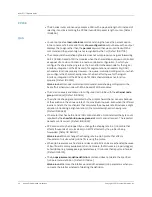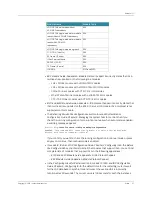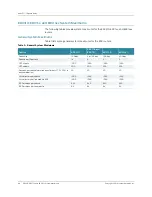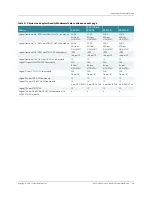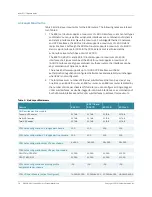
JunosE 11.1.1 Release Notes
60
Errata
Copyright © 2010, Juniper Networks, Inc.
z
In the
Monitoring MLD
section in
JunosE Multicast Routing Configuration Guide,
Chapter 6, Configuring Multicast Listener Discovery
, the following corrections apply to
the commands used to monitor MLD configuration:
−
In the
show ipv6 mld
command section, the field name "learned groups" (which
denotes the number of multicast groups that the virtual router has discovered) in
the bulleted list of field descriptions and output example for this command is
incorrect. The correct field name for this setting is "learnt groups".
−
In the
show ipv6 mld interface
command section, the field name "Groups
learned" (which denotes the number of multicast groups that the interface has
discovered) in the bulleted list of field descriptions and output example for this
command is incorrect. The correct field name for this setting is "Groups learnt".
z
In the
Aggregating Routes
section in
JunosE BGP and MPLS Configuration Guide,
Chapter 1, Configuring BGP Routing
, the references to the router, “Snakes”, in the
description that precedes the “Configuring Aggregate Addresses” figure are incorrect.
The correct references for this router are “SanJose”, which is the label used for this
router in the figure.
z
In the
Detecting Peer Reachability with BFD
section in
JunosE BGP and MPLS
Configuration Guide, Chapter 1, Configuring BGP Routing
, the
neighbor
bfd-liveness-detection
command subsection incorrectly states the following:
If you remove the BFD configuration while the BGP sessions and the BFD protocol
session are up, then the BGP session may flap because the remote BGP speaker
cannot detect why the BFD session went down.
The correct behavior of BGP sessions, when you remove the BFD configuration for
the last client tied to a BFD session, is as follows:
If you remove the BFD configuration while the BGP sessions and the BFD protocol
session are up, BFD moves to the Admin Down state and communicates the change
to the peer to enable the client protocols to handle this transition in a seamless
manner without going down. For the Admin Down state to work, the peer, which
receives the Admin Down state notification, must have the capability to distinguish
between administratively down state and real link down.
z
In the
Example: Aggregate Marking with Oversubscription Rate-Limiting Hierarchical
Policy
section in
Chapter 5, Creating Rate-Limit Profiles
of the
JunosE Policy
Management Configuration Guide
, the references to the sample ToS values marked
for color-coded traffic packets in the description, the command examples, and the
figure are incorrect. In this section, the sample values that can be configured for ToS
marks, using the green-mark, yellow-mark, and red-mark commands, are specified
as a string of characters. The correct ToS marks that can be configured for
color-coded packets using these commands are of the numerical format (a value in
the range 0–255).
See
Appendix B, Applying a ToS Mark to Color-Coded Packets in Aggregate Rate-Limit
Hierarchical Policies
, in these
Release Notes
for updated information.
Informational Note:
The BFD Admin Down state is used to bring down a BFD
session administratively, to protect client applications from BFD configuration
removal, license issues, and clearing of BFD sessions.

